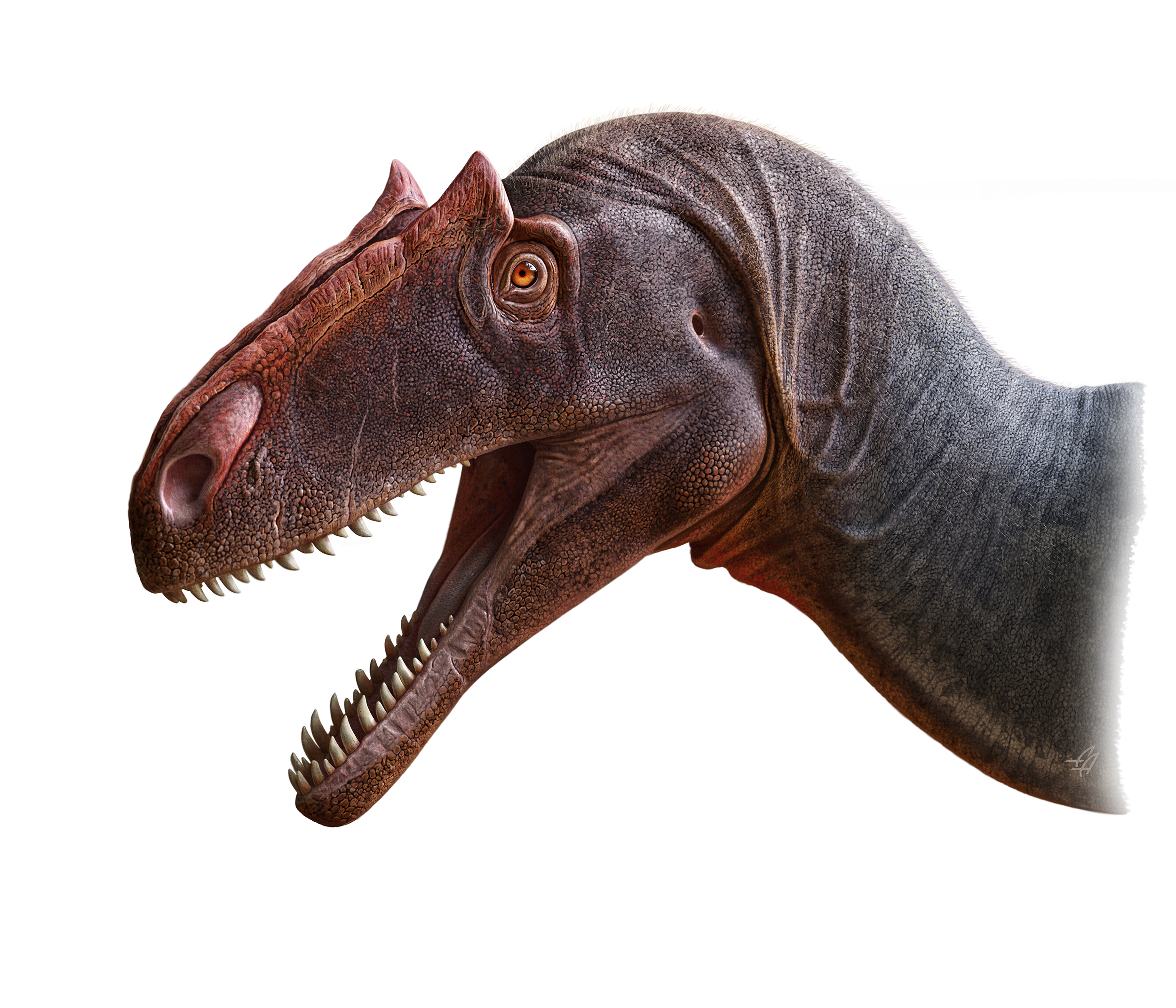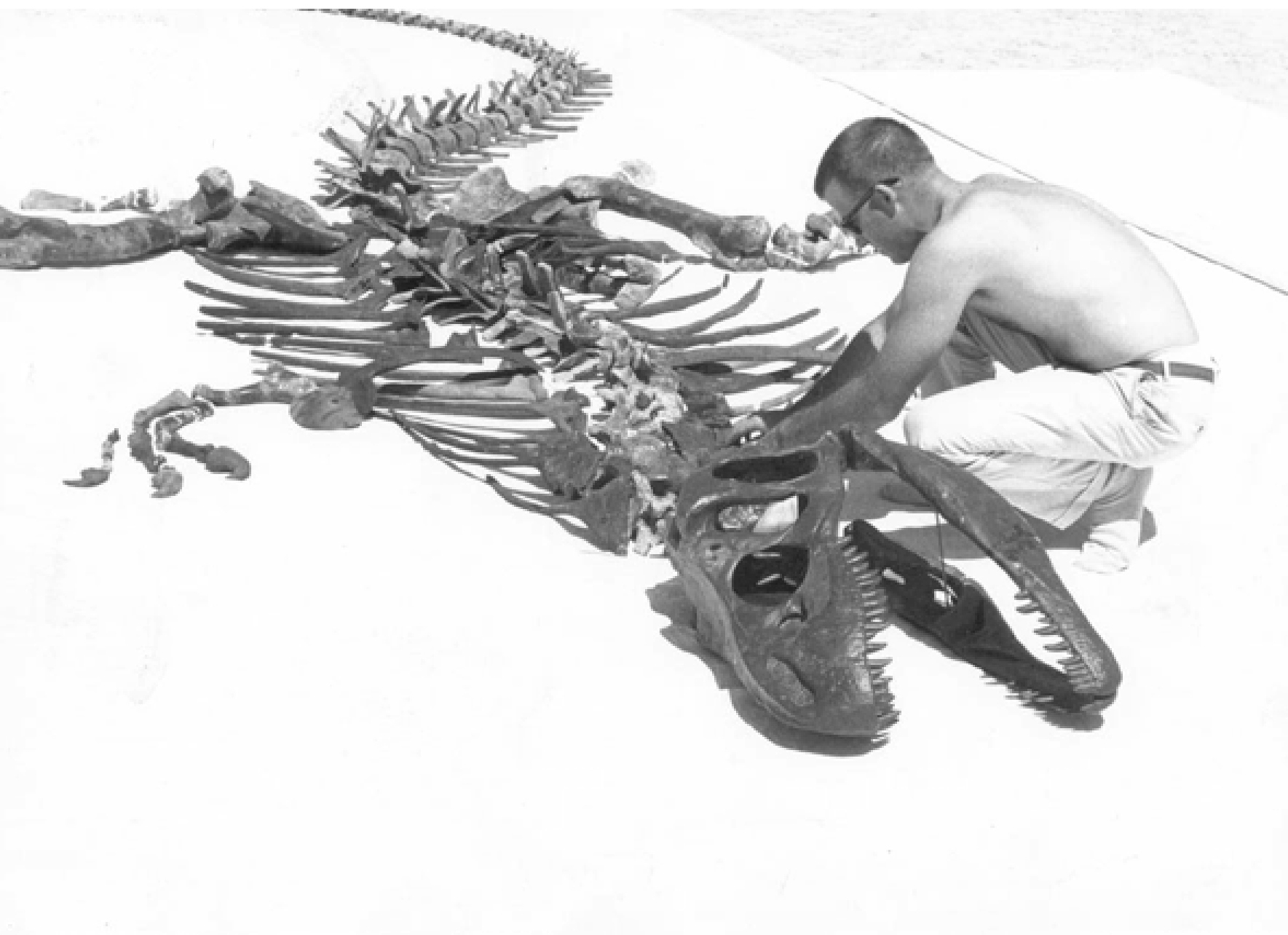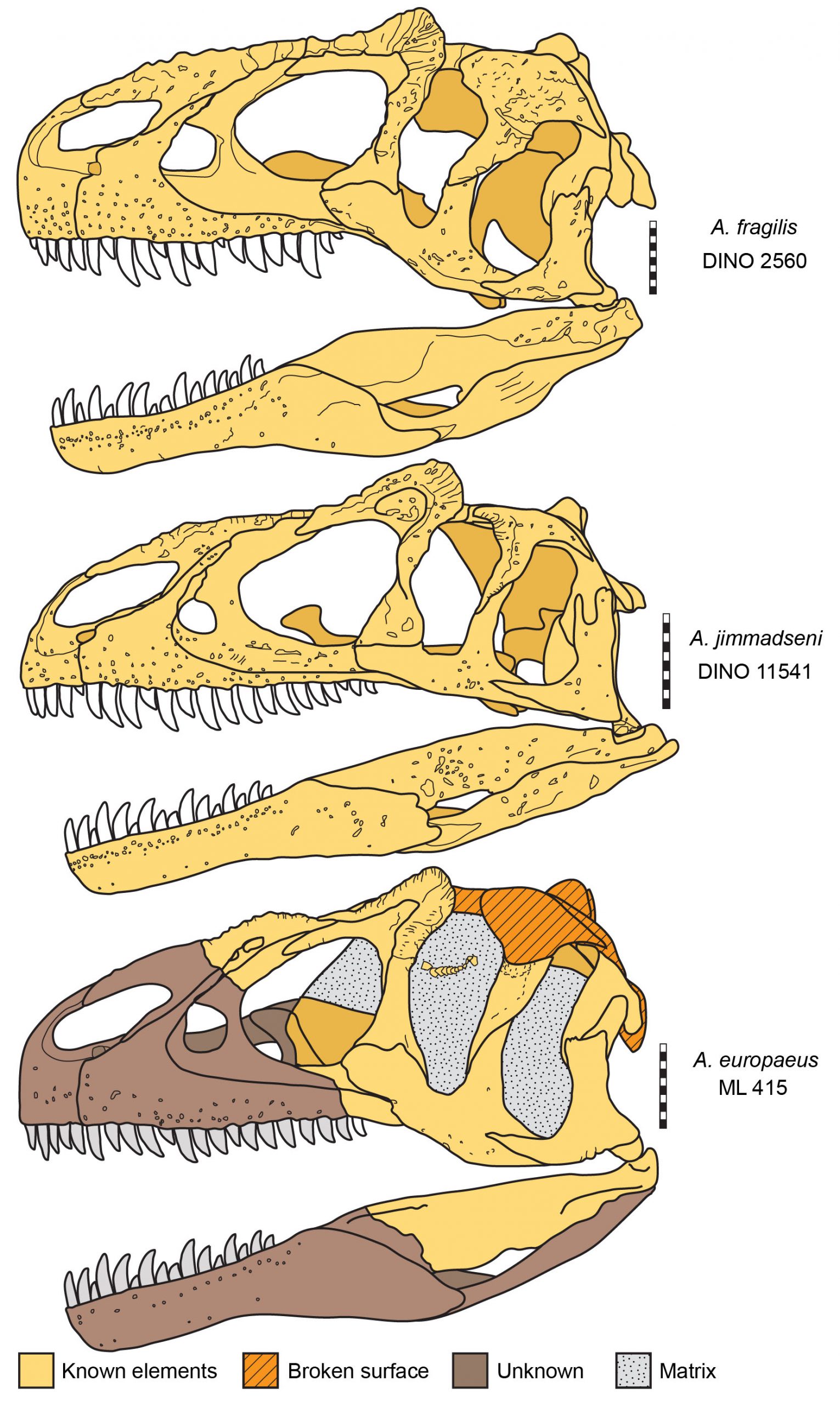A remarkable new species of meat-eating dinosaur has been unveiled at the Natural History Museum of Utah. Paleontologists unearthed the first specimen in early 1990s in Dinosaur National Monument in northeastern Utah. The huge carnivore inhabited the flood plains of western North America during the Late Jurassic Period, between 157-152 million years ago, making it the geologically oldest species of Allosaurus, predating the more well-known state fossil of Utah, Allosaurus fragilis. The newly named dinosaur Allosaurus jimmadseni, was announced today in the open-access scientific journal PeerJ.

PHOTO CREDIT: Andrey Atuchin
Allosaurus jimmadseni, a new species of dinosaur discovered in Utah, has a distinctive crests that run from the eyes to the nose.
The species belongs to the allosauroids, a group of small to large-bodied, two-legged carnivorous dinosaurs that lived during the Jurassic and Cretaceous periods. Allosaurus jimmadseni, possesses several unique features, among them a short narrow skull with low facial crests extending from the horns in front of the eyes forward to the nose and a relatively narrow back of the skull with a flat surface to the bottom of the skull under the eyes. The skull was weaker with less of an overlapping field of vision than its younger cousin Allosaurus fragilis. Allosaurus jimmadseni evolved at least 5 million years earlier than fragilis, and was the most common and the top predator in its ecosystem. It had relatively long legs and tail, and long arms with three sharp claws. The name Allosaurus translates as “different reptile,” and the second part, jimmadseni, honors Utah State Paleontologist James H. Madsen Jr.

PHOTO CREDIT: J. Willard Marriot Library
Paleontologist James Madsen Jr assembles a composite skeleton of Allosaurus from the Clevland Lloyd Dinosaur Quarry
Following an initial description by Othniel C. Marsh in 1877, Allosaurus quickly became the best known—indeed the quintessential—Jurassic theropod. The taxonomic composition of the genus has long been a debate over the past 130 years. Paleontologists argue that there are anywhere between one and 12 species of Allosaurus in the Morrison Formation of North America. This study recognizes only two species—A. fragilis and A. jimmadseni.
“Previously, paleontologists thought there was only one species of Allosaurus in Jurassic North America, but this study shows there were two species—the newly described Allosaurus jimmadseni evolved at least 5 million years earlier than its younger cousin, Allosaurus fragilis,” said co-lead author Mark Loewen, research associate at the Natural History Museum of Utah, and associate professor in the Department of Geology and Geophysics at the University of Utah led the study. “The skull of Allosaurus jimmadseni is more lightly built than its later relative Allosaurus fragilis, suggesting a different feeding behavior between the two.”
“Recognizing a new species of dinosaur in rocks that have been intensely investigated for over 150 years is an outstanding experience of discovery. Allosaurus jimmadseni is a great example of just how much more we have to learn about the world of dinosaurs. Many more exciting fossils await discovery in the Jurassic rocks of the American West,” said Daniel Chure, retired paleontologist at Dinosaur National Monument and co-lead author of the study.

PHOTO CREDIT: Dan Chure
A cast of the skeleton and skull of Allosaurus jimmadseni as it was discovered and now on exhibit at Dinosaur National Monument in Utah. The original skeleton was molded and cast before it was taken apart and prepared for study and research.
George Engelmann of the University of Nebraska, Omaha initially discovered the initial skeleton of the new species within Dinosaur National Monument in 1990. In 1996, several years after the headless skeleton was collected, the radioactive skull belonging to the skeleton using a radiation detector by Ramal Jones of the University of Utah. Both skeleton and skull were excavated by teams from Dinosaur National Monument.
“Big Al,” another specimen belonging to the new species, was discovered in Wyoming on United States Bureau of Land Management (BLM) land in 1991 and is housed in the collections of the Museum of The Rockies in Bozeman, Montana. Previously thought to belong to Allosaurus fragilis, “Big Al” was featured in the BBC’s 2001 “Walking with Dinosaurs: Ballad of Big Al” video. Over the last 30 years, crews from various museums have collected and prepared materials of this new species. Other specimens include “Big Al Two” at the Saurier Museum Aathal in Switzerland and Allosaurus material from the Dry Mesa Quarry of Colorado at Brigham Young University.
“This exciting new study illustrates the importance of continued paleontological investigations on public lands in the West. Discovery of this new taxon of dinosaur will provide important information about the life and times of Jurassic dinosaurs and represents another unique component of America’s Heritage,” said Brent Breithaupt, BLM regional paleontologist.
Early Morrison Formation dinosaurs were replaced by some of the most iconic dinosaurs of the Late Jurassic

PHOTO CREDIT: Todd Marshall
Allosaurus jimmadseni attack juvenile sauropod.
Allosaurus jimmadseni lived on the semi-arid Morrison Formation floodplains of the interior of western North America. The older rocks of the Morrison Formation preserve a fauna of dinosaurs distinct from the iconic younger Morrison Formation faunas that include Allosaurus fragilis, Diplodocus and Stegosaurus. Paleontologists have recently determined that specimens of this new species of dinosaur lived in several places throughout the western interior of North America (Utah, Colorado and Wyoming).
The study was funded by the Dinosaur National Monument, the U.S. National Parks Service, the Natural History Museum of Utah, the University of Utah, the Paleontological Society, the Jurassic Foundation, the Bureau of Land Management and the National Science Foundation.
Study summary
Dinosaurs were the dominant members of terrestrial ecosystems during the Mesozoic. However, the pattern of evolution and turnover of ecosystems during the middle Mesozoic remains poorly understood. The authors report the discovery of the earliest member of the group of large-bodied allosauroids in the Morrison Formation ecosystem that was replaced by Allosaurus fragilis and illustrate changes acquired in the genus over time. The study includes an in-depth description of every bone of the skull and comparisons with the cranial materials of other carnivorous dinosaurs. Finally, the study recognizes just two species of Allosaurus in North America with Allosaurus fragilis replacing its earlier relative Allosaurus jimmadseni.

PHOTO CREDIT: Chure and Loewen Peerj (2020)
Three species of Allosaurus
Fact sheet: Major points of the paper
- A remarkable new species of meat-eating dinosaur, Allosaurus jimmadseni, is described based on two spectacularly complete skeletons. The first specimen was unearthed in Dinosaur National Monument, in northeastern Utah.
- Allosaurus jimmadseni is distinguished by a number of unique features, including low crests running from above the eyes to the snout and a relatively narrow back of the skull with a flat surface to the bottom of the upper skull under the eyes. The skull was weaker with less of an overlapping field of vision than its younger cousin Allosaurus fragilis.
- At 155 million years old, Allosaurus jimmadseni is the geologically-oldest species of Allosaurus predating the more well-known State Fossil of Utah Allosaurus fragilis.
- Allosaurus jimmadseni was the most common and the top predator in its ecosystem. It had relatively long legs and tail, and long arms with three sharp claws.
Study design
- Comparison of the bones with all other known allosauroid dinosaurs indicate that the species possessed unique features of the upper jaw and cheeks (maxilla and jugal) and a decorative crest stretching from just in front of the eyes to the nose.
- Many of the comparisons were made with the thousands of bones of Allosaurus fragilis collected from the famous Cleveland-Lloyd Dinosaur Quarry administered by the Bureau of Land Management that are housed in the collections of the Natural History Museum of Utah.
- On the basis of these features, the scientific team named it a new genus and species of dinosaur, Allosaurus jimmadseni (translating to “Jim Madsen’s different reptile”).
- Allosaurus jimmadseni is particularly notable for its slender, narrow skull with short sharp nasal crests compared to its close relative and successor Allosaurus fragilis.
- The study was funded in part by the University of Utah, the National Park Service and the National Science Foundation.
New dinosaur name: Allosaurus jimmadseni
- The first part of the name, Allosaurus, (a·luh·SAWruhs) can be translated from Greek as the “other”, “strange” or “different” and “lizard” or “reptile” literally to “different reptile”. The second part of the name jimmadseni(gym-MAD-sehn-eye) honors the late Utah State Paleontologist James Madsen Jr. who excavated and studied tens of thousands of Allosaurus bones from the famous Cleveland-Lloyd Dinosaur Quarry in central Utah and contributed greatly to the knowledge of Allosaurus.
Size
- Allosaurus jimmadseni was approximately 26 to 29 feet (8-9 meters) long.
- Allosaurus jimmadseni weighed around 4000 lbs. (1.8 metric tonnes).
Relationships
- Allosaurus jimmadseni belongs to a group of carnivorous dinosaurs called “allosauroids,” the same group as the famous Allosaurus fragilis.
- Other dinosaurs found in rocks containing Allosaurus jimmadseni include the carnivorous theropods Torvosaurus and Ceratosaurus; the long-necked sauropods Haplocanthosaurus and Supersaurus; and the plate-backed stegosaur
- Allosaurus jimmadseni is closely related to the State Fossil of Utah, Allosaurus fragilis.
Anatomy
- Allosaurus jimmadseni was a two-legged carnivore, with long forelimbs and sharp, recurved claws that were likely used for grasping prey.
- Like other allosauroid dinosaurs, Allosaurus jimmadseni had a large head full of 80 sharp teeth. It was alsothe most common carnivore in its ecosystem.
Age and geography
- Allosaurus jimmadseni lived during the Kimmeridgian stage of the Late Jurassic period, which spanned from approximately 157 million to 152 million years ago.
- Allosaurus jimmadseni lived in a semi-arid inland basin filled with floodplains, braided stream systems, lakes, and seasonal mudflats along the western interior of North America.
- Allosaurus jimmadseni represents the earliest species of Allosaurus in the world.
Discovery
- Allosaurus jimmadseni can be found in a geologic unit known as the Salt Wash Member of the Morrison Formation and its equivalents exposed in Colorado, Wyoming, and Utah.
- The first specimen of Allosaurus jimmadseni was discovered in the National Park Service administered by Dinosaur National Monument in Uintah County, near Vernal, Utah.
- Allosaurus jimmadseni was first discovered by George Engelmann of the University of Nebraska, Omaha on July 15, 1990 during a contracted paleontological inventory of the Morrison Formation of Dinosaur National Monument.
- Another specimen of Allosaurus jimmadseni known as “Big Al,” was found on land administered by the U.S. Department of the Interior’s Bureau of Land Management in Wyoming.
- Further specimens of Allosaurus jimmadseni have been subsequently recognized in the collections of various museums.
- Allosaurus jimmadseni specimens are permanently housed in the collections of Dinosaur National Monument, Utah; the Museum of the Rockies, Bozeman, Montana; the Saurier Museum of Aathal, Switzerland; the South Dakota School of Mines, Rapid City, South Dakota; Brigham Young University’s Museum of Paleontology, Provo, Utah; and the United States National Museum (Smithsonian) Washington D.C.
- These discoveries are the result of a continuing collaboration between the Natural History Museum of Utah, the National Park Service, and the Bureau of Land Management.
Excavation
- The first skeleton of Allosaurus jimmadseni was excavated during the summers of 1990 to 1994 by staff of the National Park Service’s Dinosaur National Monument. The skeleton block was so heavy it required the use of explosives to remove surrounding rock and a helicopter to fly out the 2700 kg block. The head of the skeleton was missing
- The first bones of Allosaurus jimmadseni discovered included toes and some tail vertebrae. Later excavation revealed most of an articulated skeleton missing the head and part of the tail.
- The radioactive skull of the first specimen of Allosaurus jimmadseni, which had previously eluded discovery, was found in 1996 by Ramal Jones of the University of Utah using a radiation detector.
Preparation
- It required seven years to fully prepare all of the bones of Allosaurus jimmadseni.
- Much of the preparation was done by then Dinosaur National Monument employees Scott Madsen and Ann Elder, with some assistance from Dinosaur National Monument volunteers and students at Brigham Young University.
Other
- The Natural History Museum of Utah houses the world’s largest collection of Allosaurus fossils, which are frequently studied by researchers from around the world.
- More than 270 National Park Service (NPS) areas preserve fossils even though only 16 of those were established wholly or in part for their fossils. Fossils in NPS areas can be found in the rocks or sediments of a park, in museum collections, and in cultural contexts (building stones, artifacts, historical legends, and documents).
- The United States Bureau of Land Management manages more land—247 million acres—than any other federal agency, and manages paleontological resources using scientific principles and expertise.



